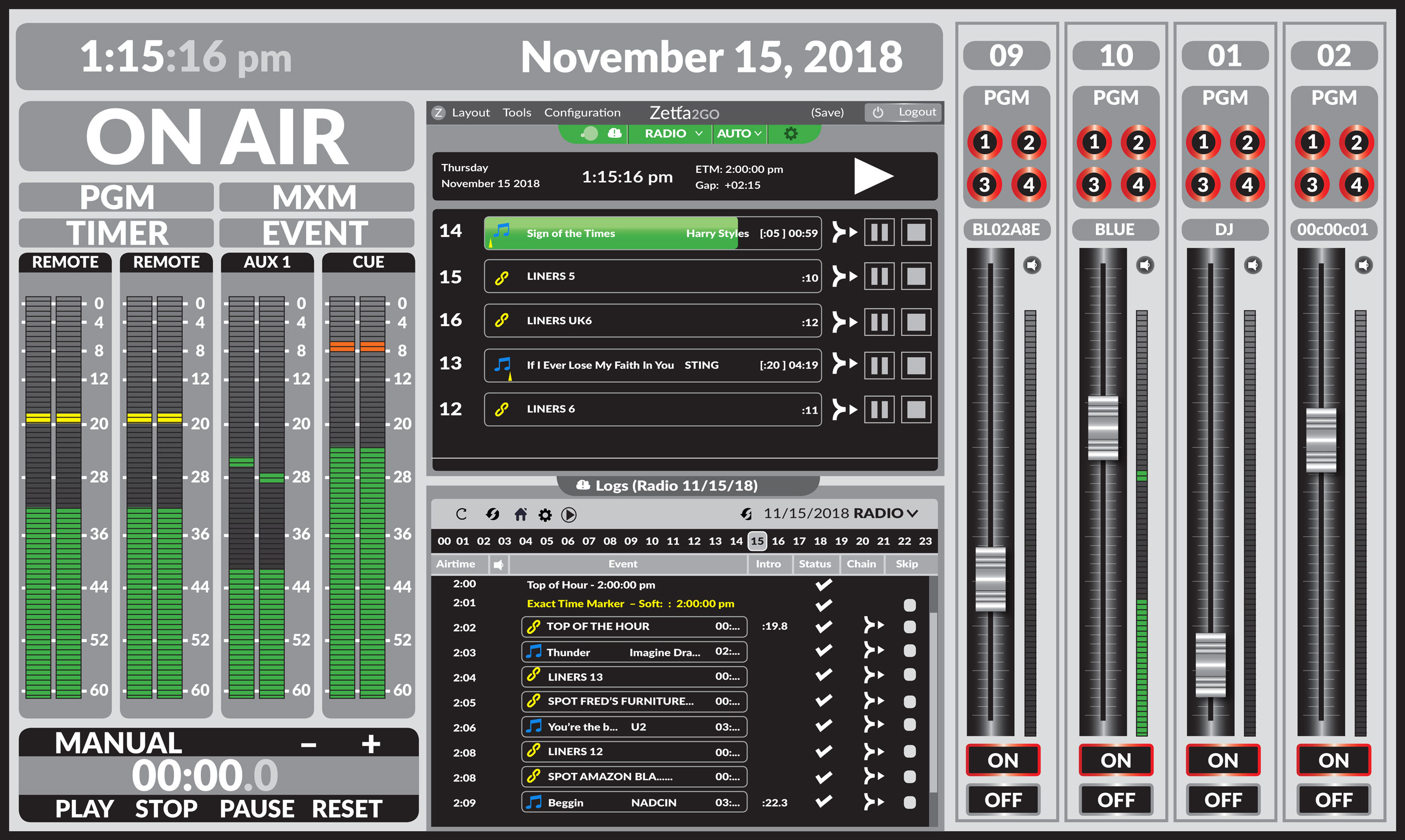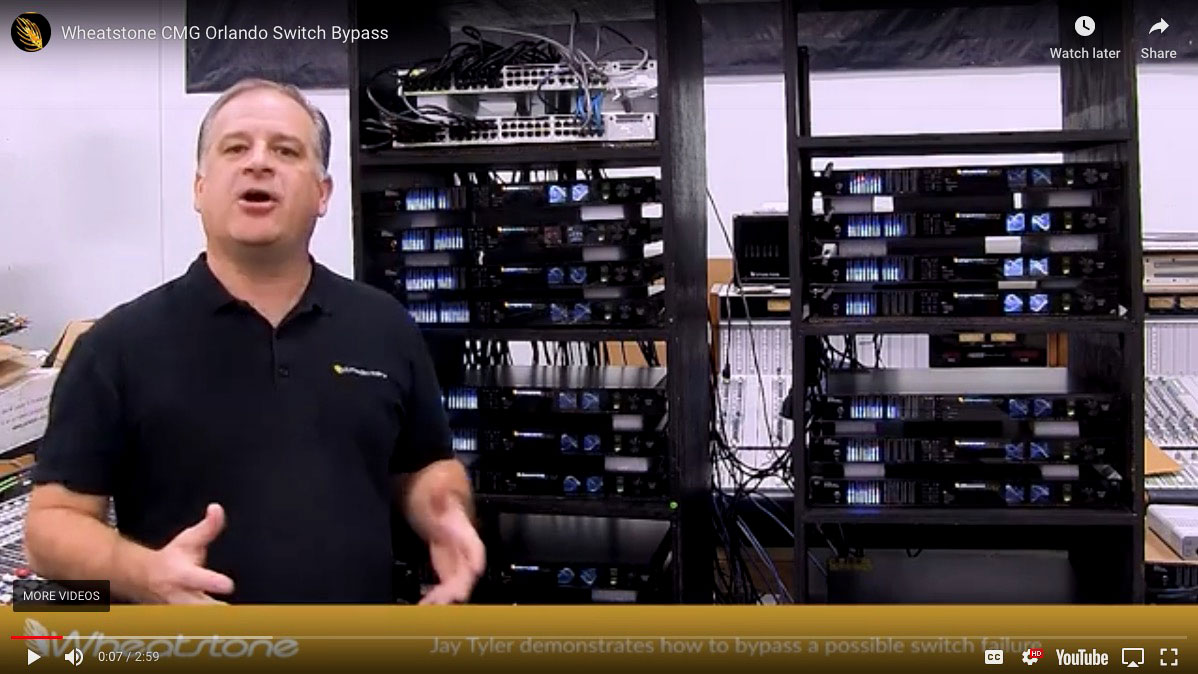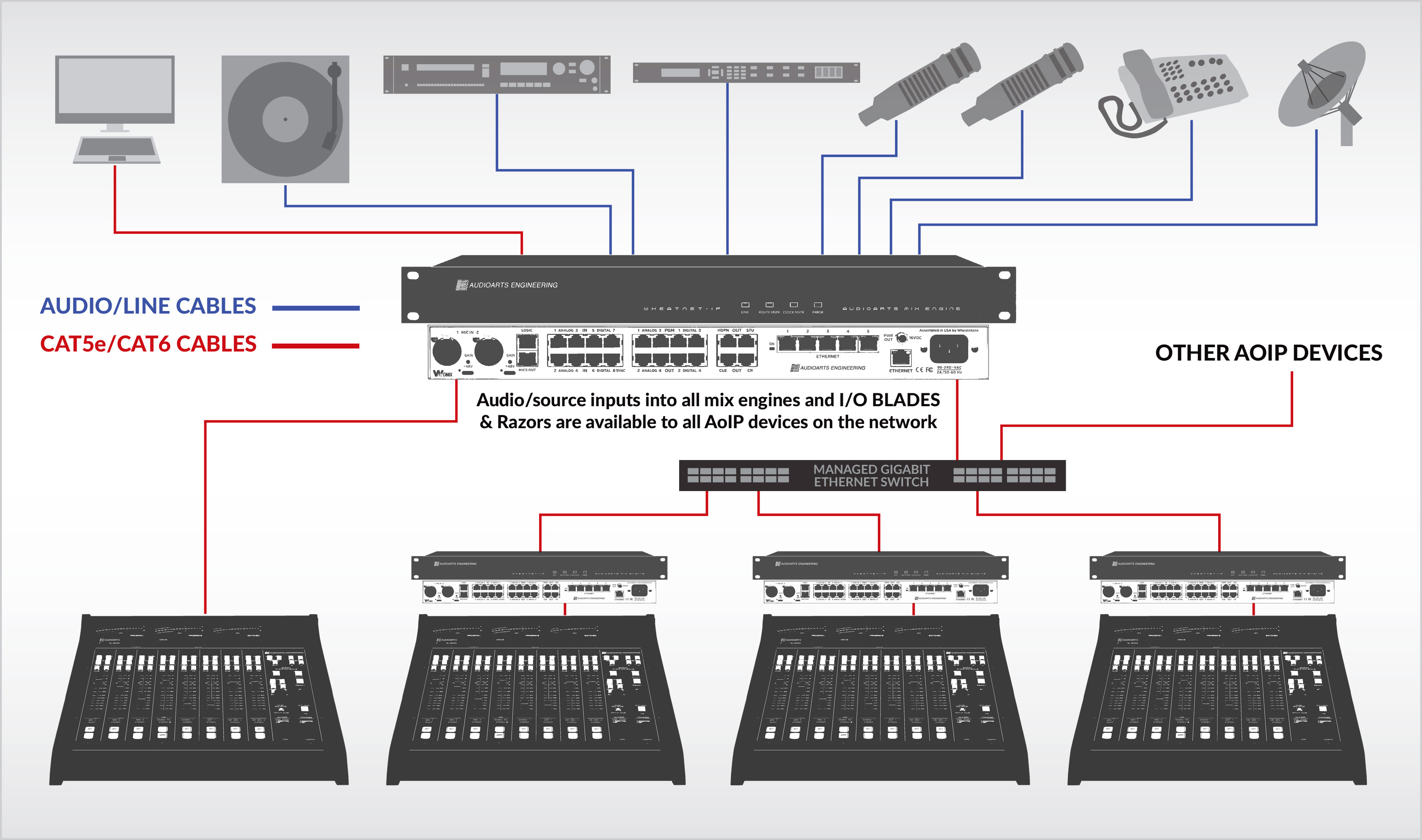WHEAT:NEWS FEBRUARY 2020 Volume 11, Number 2
How One AM Became a Top 10 Station
 While the industry discusses the pros and cons of all-digital AM, we’re just starting to hear from AM broadcasters who jumped onto FM translators as part of AM revitalization.
While the industry discusses the pros and cons of all-digital AM, we’re just starting to hear from AM broadcasters who jumped onto FM translators as part of AM revitalization.
Many of them report favorable outcomes similar to that of WECK-AM, a 1kW on 1230 kHz in Buffalo, New York, that has two FM translators and was just approved for a third. Local broadcaster Buddy Shula purchased WECK-AM in 2017 with the intention of adding translators, and we’re told that WECK now ranks as one of the top 10 listened-to stations in the Buffalo market as a result.
We heard from WECK-AM CE Dennis Majewicz soon after WECK began simulcasting its Oldies format on translator 102.9 MHz centered on Buffalo (100.5 MHz reaching the northern suburbs of Buffalo was soon to follow). He said he quickly realized that the spare audio processor he planned to use couldn’t cut through the din on the FM dial. “We’re running an Oldies format of 50s, 60s and some 70s music and in terms of recording quality, it was hard to maintain a consistent sound. The old processor was all over the place,” explained Majewicz, who installed a new FM-55 audio processor instead. The FM-55’s AGC section uses “intelligent” multiband gain control for real-time program density control, resulting in a consistent, spectrally-balanced sound regardless of density variations in incoming source material.
The FM-55 now feeds both translators; the spare processor was subsequently moved to the AM air chain. “There’s very little you can do to make an apparent difference on AM, whereas FM has more bandwidth and is wide open,” commented Majewicz.
“The FM-55 is a lot more sophisticated. It opens up the sound,” he added.
The FM-55 is credited with giving WECK consistent levels, refined overshoot protection, and a deep bass that doesn’t affect mid and high frequencies.
WECK is about to add a third FM translator in as many years of operation under owner Buddy Shula. The third translator on 100.1 MHz will cover the northeastern area of Buffalo and has the potential to add up to 200,000 listeners for WECK.
With AM, streaming, and soon to be three FM translators keeping WECK relevant to listeners, an all-digital AM band is less of a gamble for one of Buffalo’s top ten stations.
The Wheat Store is Open
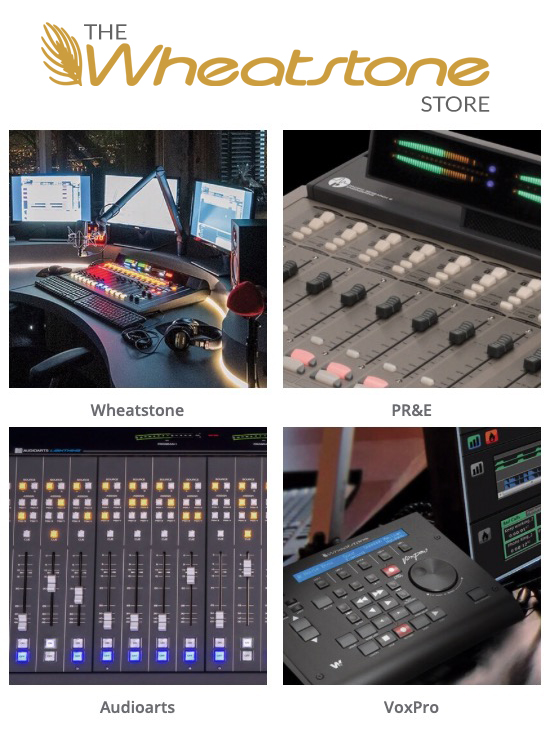 The Wheatstone online parts store is now open! You can purchase spare cards, subassemblies, modules and other discontinued or out-of-production components for Wheatstone, Audioarts, PR&E and VoxPro products online, or call Wheatstone customer support at 252-638-7000 or contact the Wheatstone technical support team online as usual.
The Wheatstone online parts store is now open! You can purchase spare cards, subassemblies, modules and other discontinued or out-of-production components for Wheatstone, Audioarts, PR&E and VoxPro products online, or call Wheatstone customer support at 252-638-7000 or contact the Wheatstone technical support team online as usual.
The store is another convenience at wheatstone.com, where you can access product manuals, white papers and tutorials as well as technical and discussion forums such as its AoIP Scripters Forum.
NAB 2020 Starts Now!
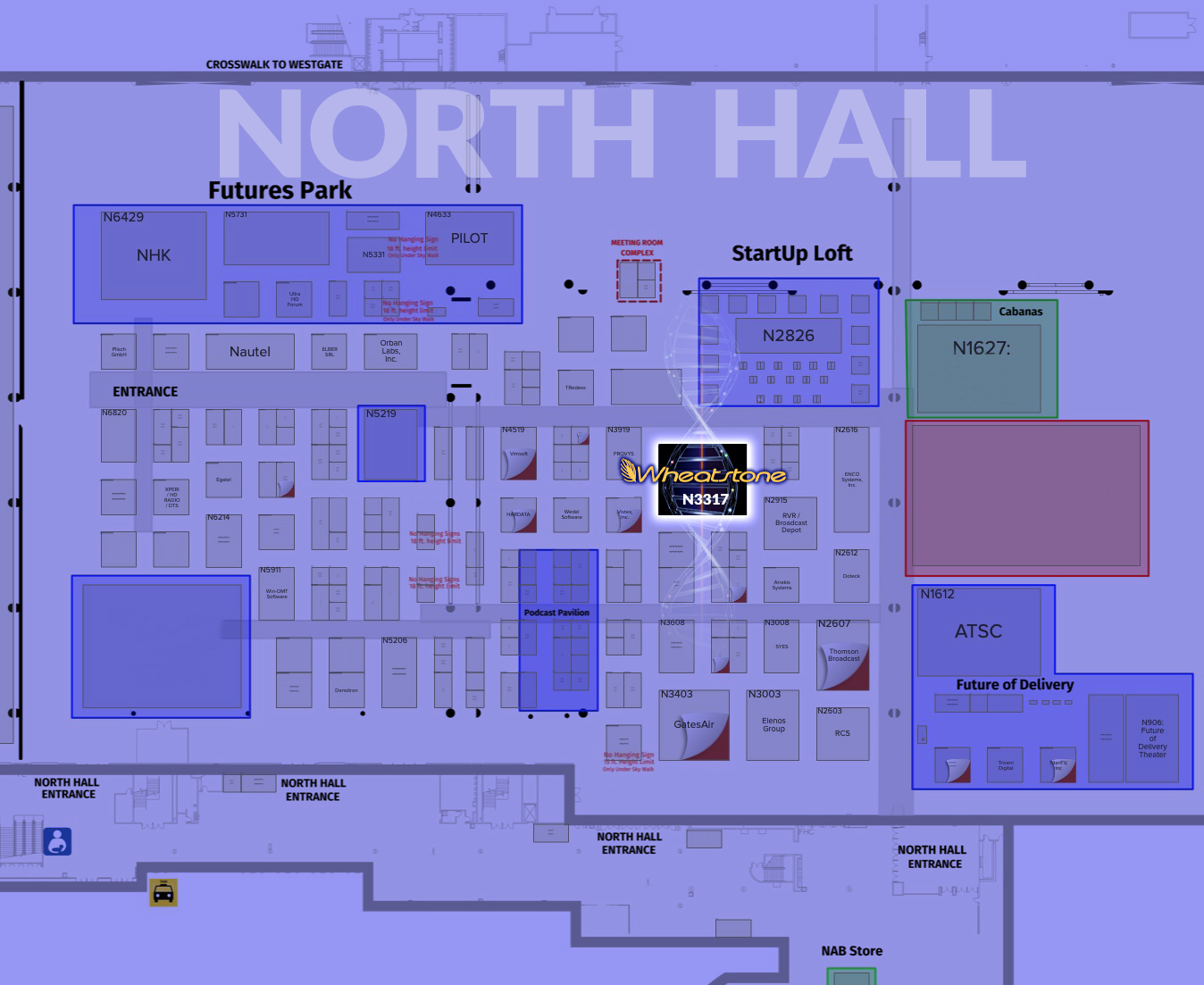 Still need to register for NAB? Go to website and use our registration code LV8258 to get into the exhibit hall.
Still need to register for NAB? Go to website and use our registration code LV8258 to get into the exhibit hall.
We have several new products and new AoIP applications we can’t wait to show you!
Look for Wheatstone booth N3317 in the North Hall across from the StartUp Loft and a few steps from Futures Park. See you there.
ScreenBuilder Scripter's Forum
Are you a ScreenBuilder or ConsoleBuilder power user? Register and log onto our Scripters Forum. This is a new meeting place for anyone interested in developing new screens and workflows for our WheatNet-IP audio network. Share scripts, screen shots and ideas with others also developing virtual news desks, control panels, and signal monitors. You’ll find documents, starter scripts and a whole knowledge base available to you for making customized screens like those pictured.
Switching it Up
In this video, Jay Tyler demonstrates a fully redundant WheatNet-IP audio network and what to do in the event of a switch failure.
Analog Exit Plan. Step 1: Convert Wiring One Device at a Time.
By Richard Maddox
If you’re currently supporting analog routing and planning to transition to AoIP, you can begin by converting existing wiring one device at a time.
Almost all new between-equipment wiring is using unshielded CAT5e or CAT6 cables. These two CAT cables, which have identical specs for our uses, can be used interchangeably to connect analog audio, AES-3 audio, AoIP audio streams, ethernet for KVMs and VoIP/SIP phones, and, of course, your facility’s LAN connections. Many broadcasters have standardized on using UTP (unshielded twisted pair) CAT5e as their interconnection cable of choice. CAT6 has a thicker sheathing and tighter twists in its four wire pairs than CAT5e, which makes it more resistant to crosstalk but also slightly harder to handle.
When moving to category cables, there are two main approaches: either buy pre-made “patch cables” in various common lengths like 6-foot, 15-foot, 25-foot, etc., or buy reels of raw CAT5e cable and bags or boxes of RJ45 plugs so you can create your own custom-length cables. It really boils down to how much time you have and how much you like crimping RJ45 plugs onto cables.
Since the IT industry uses CAT5e and CAT6 cables by the truckload, the price for category cabling and plugs means your cabling cost for an entire facility (whether making custom length cables yourself or using off-the-shelf “bagged” cables) is a fraction of what it would cost to run shielded balanced audio cables.
Adapting Cable for Broadcast
Since most audio and broadcast equipment has not transitioned to adding an RJ45 jack for their analog or AES signals, you’ll still need XLR or TRS plugs on your cables, which means you’ll need to terminate your CAT5e cabling at one end to something other than RJ45. You could solder the plugs directly to the category cable wire pairs, but that’s messy and time-consuming. An easier solution, which will run you about $20 or so, is to use RJ45-to-XLR and RJ45-to-TRS adapters to connect new equipment using CAT5e without having to solder anything.
RJ45 adapters are available for just about every connector type, but not for the AMP MOD IV plugs used since the mid-90s on all PR&E consoles (except Oasis). No one makes an RJ45-to-MOD IV adapter, but there are RJ45-to-pigtail adapters, so with a bit of hand crimping of the MOD IV terminals onto the pigtails, you can roll your own MOD IV-to-RJ45 adapters.
By the way, any custom MOD IV adapter you make can be repurposed later on as an RJ45 adapter for a satellite receiver or other equipment using D-sub and other non-standard jacks.
Converting to category cabling one device at a time will set you up for AoIP and for IP audio routed consoles, which will give you features not available on your older analog consoles, like source selection, bus-minus, and audio processing on every fader. You might be surprised at how much console you can get for the money. For example, an 8-channel AoIP console like the Audioarts DMX can be had for under $8,000, pretty much the price for a NetWave-8 console from the early 00s.
Richard Maddox is a Field Service Engineer for Wheatstone, Audioarts, and PR&E products. He joined PR&E in 1993 as their Digital Product Specialist, with later stints in the Engineering, Systems Design, and Customer Service departments. When Wheatstone purchased PR&E assets, he joined Wheatstone to continue supporting legacy PR&E products. He now supports the full line of current Wheatstone-designed products from his location in Southern California.
And the Emmy Goes to…
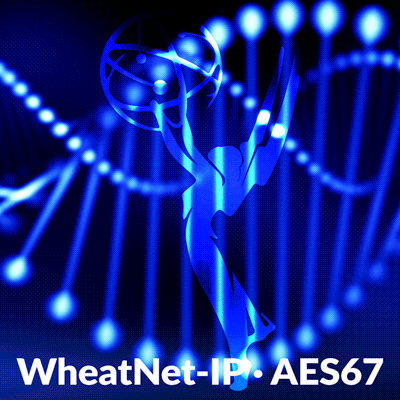 Congratulations to the Audio Engineering Society and all the companies who had the foresight to invest and co-develop for the greater good of the industry!
Congratulations to the Audio Engineering Society and all the companies who had the foresight to invest and co-develop for the greater good of the industry!
Wheatstone is a proud to stand with AES and five other technology partners to be recognized for a Technical & Engineering Emmy Award in a ceremony at the NAB Show at the Wynn Encore on Sunday, April 19. The award is being given for the “Development of synchronized multichannel uncompressed audio transport over IP networks.”
We WheatNet-IP’d Audioarts, We Sure Did!
Plus EQ'd an L-16...
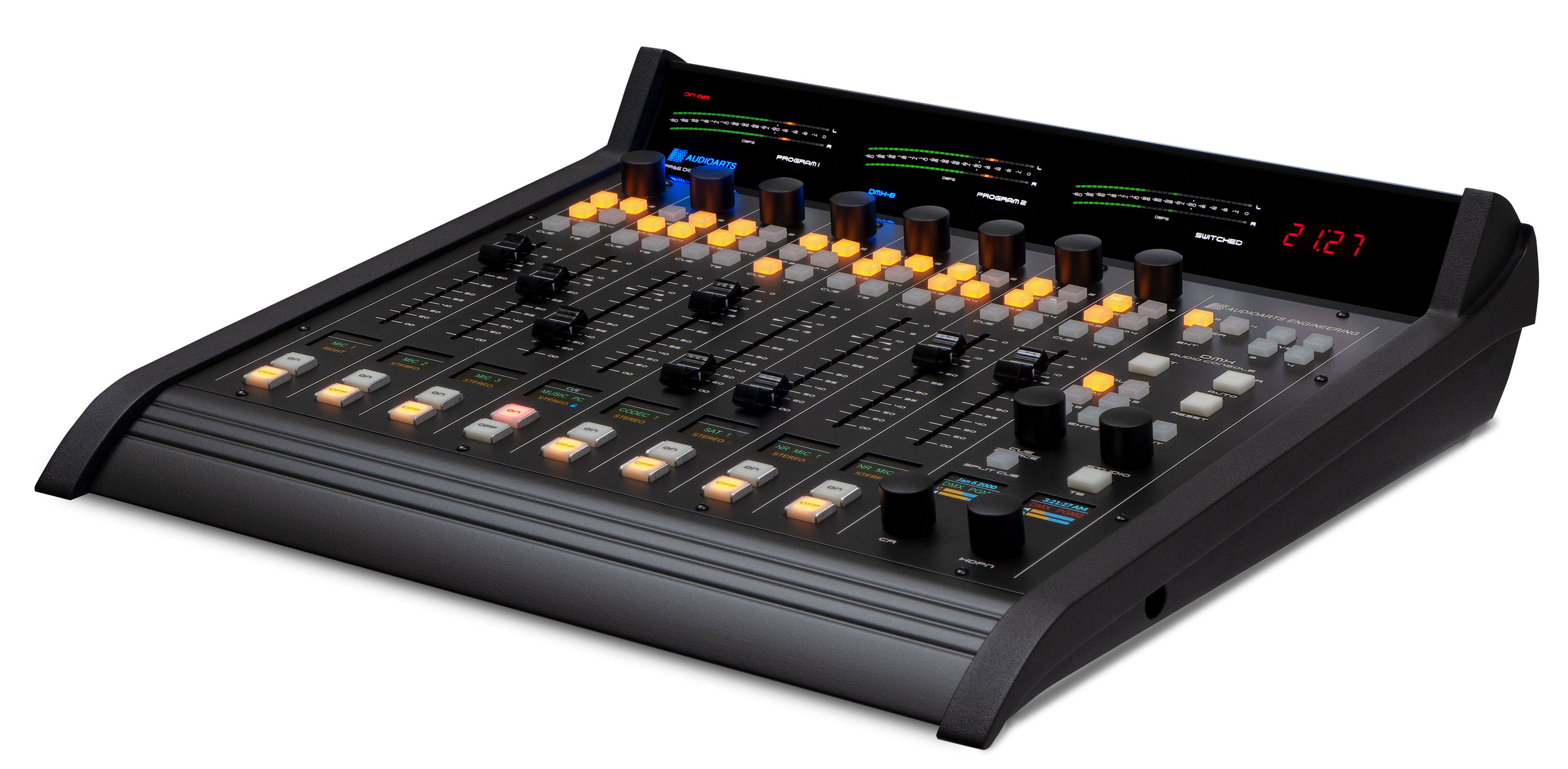 Introducing the Audioarts DMX AoIP Console - a WheatNet-IP compatible mixing control surface along with its Razor I/O devices (also WheatNet-IP compatible).
Introducing the Audioarts DMX AoIP Console - a WheatNet-IP compatible mixing control surface along with its Razor I/O devices (also WheatNet-IP compatible).
And, please extend a warm welcome to the L-16, the latest addition to our L-Series line of control surfaces, along with an optional EQ module for all L-Series consoles.
Interesting Links:
AoIP. From Here to the Cloud.
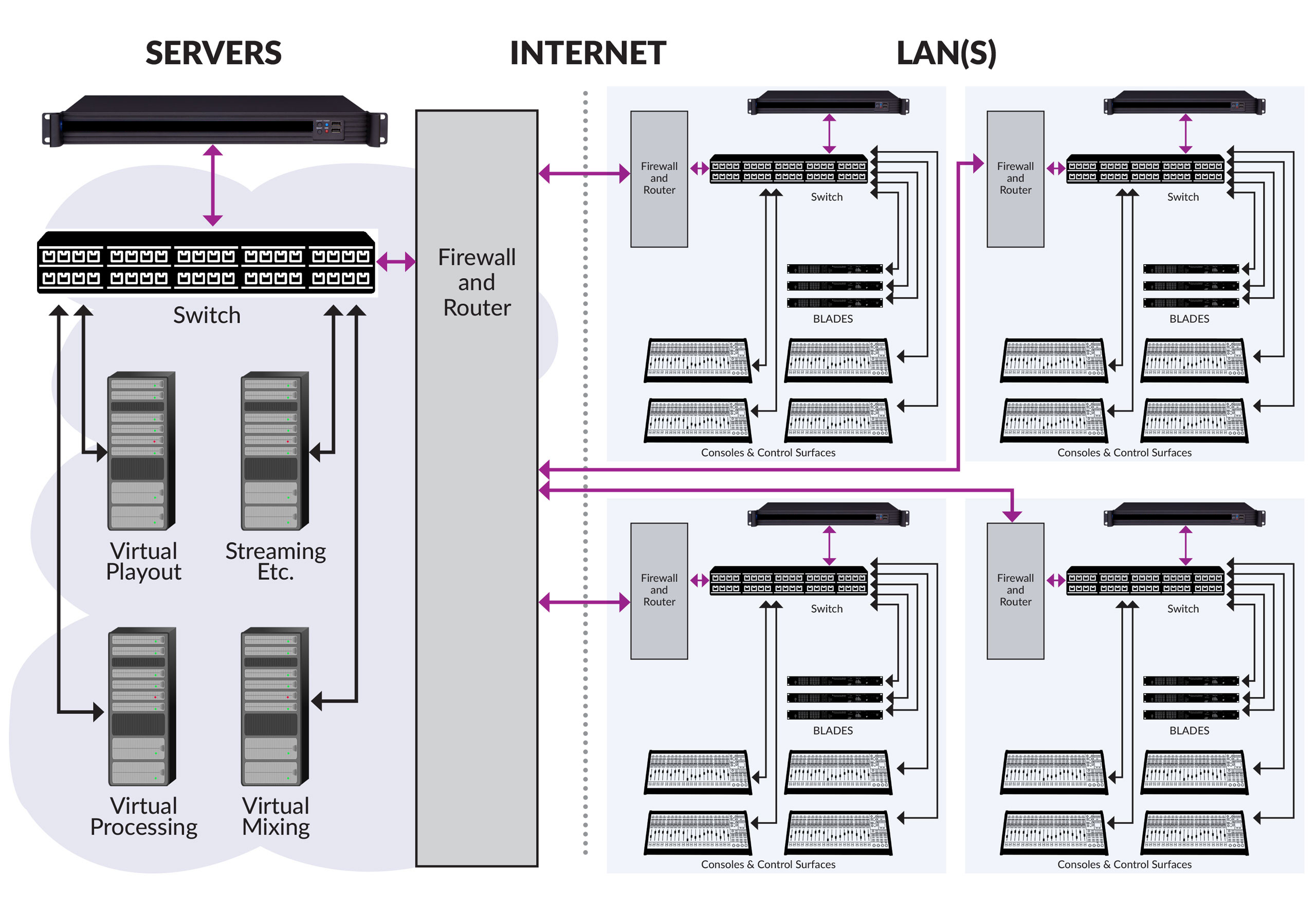 Virtualization or cloud access is a very good example of what can happen when we combine AoIP with enterprise technology.
Virtualization or cloud access is a very good example of what can happen when we combine AoIP with enterprise technology.
Currently, there are a number of cloud service providers, each with unique APIs, service level agreements and cost structures. The critical components of cloud systems include IP connectivity and supervisory software to manage access to virtual machines, which is fairly mature and in use by enterprises today.
But for broadcast purposes, we need to add two other critical components to that list:
• Audio encoding for bandwidth optimization
• AoIP control for system operation and management
Wheatstone has AoIP appliances for the WheatNet-IP audio network that include these critical components. With these additions, broadcasters can transport high-quality programming as well as the routing and control critical for full studio operation between sites.
Adding Codec Bandwidth Optimization
Unlike many enterprise applications, broadcasters rely on audio encoding to fit high-quality programming down today’s IP links. Different codecs serve different applications. WheatNet-IP audio network appliances offer high quality codecs for this purpose, such as the AAC family and Opus.
Without codecs, audio demands 1.4 Mbps of bandwidth per stereo stream plus some overhead. Codecs decrease the required bandwidth to 256 Kbps or less without any noticeable quality degradation. For local AoIP networks, this has never mattered much, which is why WheatNet-IP audio networks run uncompressed streams natively. With cloud services, bandwidth is often billed per-GB, so reducing that bandwidth usage is an important component to a cost-effective cloud implementation.
Adding Cloud Control
If co-location, centralized operation or cloud access is going to be useful, broadcasters need to be able to do the most basic of studio functions at a distance — like turn on a mic, trigger a mix-minus preset, or press a play button. They need to be able to send and receive router commands, device settings and automation control from one studio to the next or from the cloud to each of their locations.
Wheatstone appliances include interfaces for remotely triggering events and elements or changing routes in the WheatNet-IP environment, such as turning mics on or off, setting levels, or adjusting EQ dynamics.
With these appliances, broadcasters can extend full, seamless studio operation across the public Internet. They can connect together studios separated by distance, optimize the bandwidth of the links that carry their programming, and remotely control a console, mic or automation system from one facility to the next or from a network operation center halfway across the globe.
Wheatstone interfaces are used by more than 60 technology brand partners to seamlessly integrate functions and devices into the WheatNet-IP audio network environment.
Virtualization Begins Here
Virtualization began when we replaced sound cards with audio drivers, which effectively let us network audio with control functions together. Inside every WheatNet-IP audio driver are virtual general-purpose logic I/Os that can be queried by automation scripts and routed along with audio signals to perform control functions.
At the same time, we put mixing as a service on the network.
I/O BLADE units that make up the WheatNet-IP audio network have two stereo 8x2 internal mixers, each of which can be used as a source or input to the system and therefore are very useful for grouping several mics to a single output, talkback, or other purpose.
These and other AoIP developments led the way to virtual mixers and an assortment of UIs now hanging off the network. Some WheatNet-IP audio network interfaces are simple standalone virtual consoles, others are tapthrough screens on a tablet, and still others are physical consoles with soft buttons that can be changed as easily as any virtual UI. Wheatstone offers them all, and what we haven’t created yet, broadcasters can create themselves using our ScreenBuilder app.
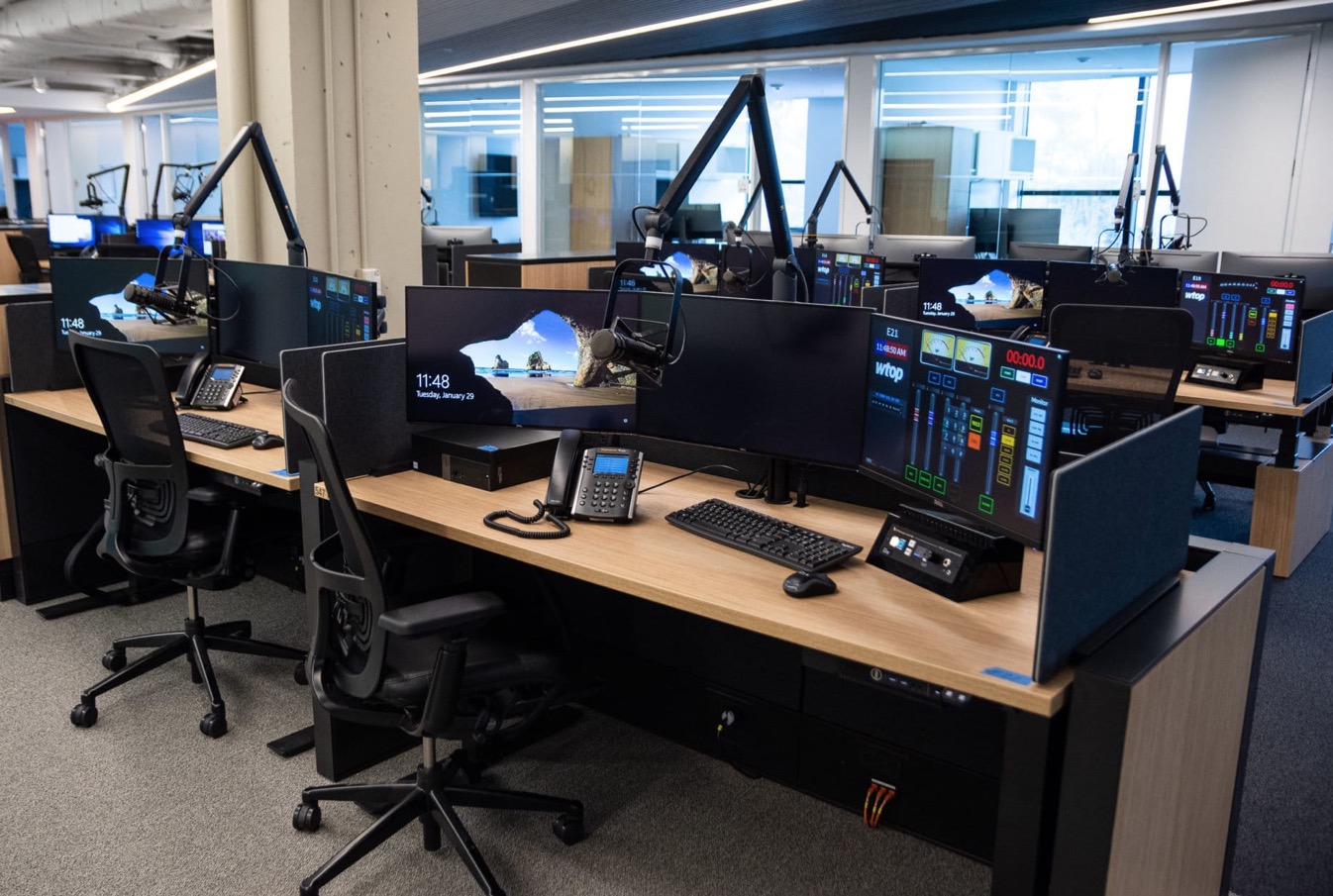 In WTOP’s new facility near Washington, D.C., for example, each of the 40-plus news and sports workstations have a small WheatNet-IP turret for headphones and mic mute. They also have a touchscreen for tapping on a VoIP phone line or remote codec, all the soft buttons of which are conveniently and automatically configured for the right mix-minus. Weather, business or network feeds are all sources on the screen, which can be shared by other hardware or soft surfaces in the almost 30,000 square foot facility.
In WTOP’s new facility near Washington, D.C., for example, each of the 40-plus news and sports workstations have a small WheatNet-IP turret for headphones and mic mute. They also have a touchscreen for tapping on a VoIP phone line or remote codec, all the soft buttons of which are conveniently and automatically configured for the right mix-minus. Weather, business or network feeds are all sources on the screen, which can be shared by other hardware or soft surfaces in the almost 30,000 square foot facility.
 Meanwhile, Townsquare Media went all glass in some of its new studios in Duluth, Minn., with Glass LXE standalone virtual consoles in place of physical surfaces. “There is not a ‘one size or type fits all,’” commented Mark T. Simpson, SVP of engineering for Townsquare Media. “If you can build it, they will use it.”
Meanwhile, Townsquare Media went all glass in some of its new studios in Duluth, Minn., with Glass LXE standalone virtual consoles in place of physical surfaces. “There is not a ‘one size or type fits all,’” commented Mark T. Simpson, SVP of engineering for Townsquare Media. “If you can build it, they will use it.”
PhoneBlade - Smart VoIP/AoIP phone system
StreamBlade - Stream WheatNet-IP
Glass LXE - Virtual LXE IP audio console
Remote LXE - Virtual remote audio console for physical LXE
X5 - FM/HD broadcast audio processor
MPX SyncLink - IP multiplex receiver for use with X5
Strata 32 - IP audio TV console
Virtual Dimension Three - Virtual Dimension Three IP audio TV console
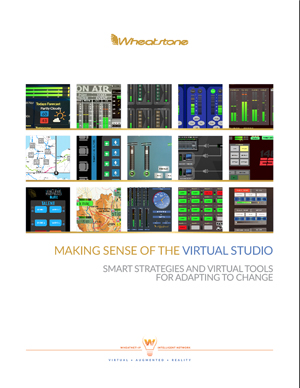 Making Sense of the Virtual Studio
Making Sense of the Virtual Studio
SMART STRATEGIES AND VIRTUAL TOOLS FOR ADAPTING TO CHANGE
Curious about how the modern studio has evolved in an IP world? Virtualization of the studio is WAY more than tossing a control surface on a touch screen. With today's tools, you can virtualize control over almost ANYTHING you want to do with your audio network. This free e-book illustrates what real-world engineers and radio studios are doing. Pretty amazing stuff.
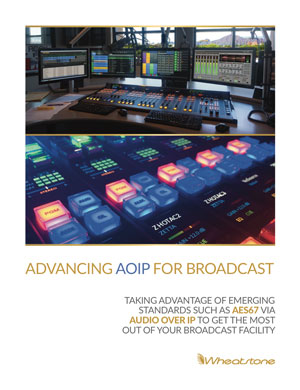 Advancing AOIP for Broadcast
Advancing AOIP for Broadcast
TAKING ADVANTAGE OF EMERGING STANDARDS SUCH AS AES67 VIA AUDIO OVER IP TO GET THE MOST OUT OF YOUR BROADCAST FACILITY
Putting together a new studio? Updating an existing studio? This collection of articles, white papers, and brand new material can help you get the most out of your venture. Best of all, it's FREE to download!
IP Audio for TV Production and Beyond
WHAT YOU NEED TO KNOW ABOUT MANAGING MORE CHANNELS, MORE MIXES, AND MORE REMOTE VENUES
For this FREE e-book download, we've put together this e-book with fresh info and some of the articles that we've authored for our website, white papers, and news that dives into some of the cool stuff you can do with a modern AoIP network like Wheatstone's WheatNet-IP.
Got feedback or questions? Click my name below to send us an e-mail. You can also use the links at the top or bottom of the page to follow us on popular social networking sites and the tabs will take you to our most often visited pages.



